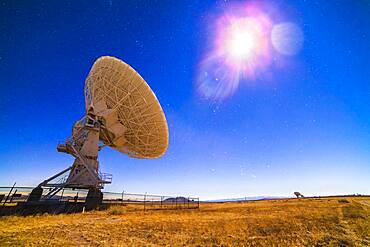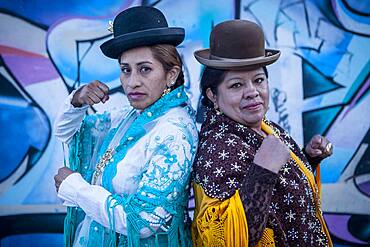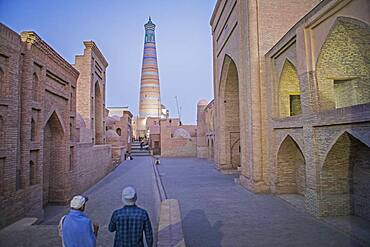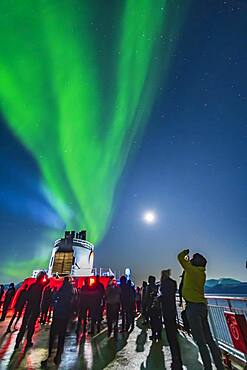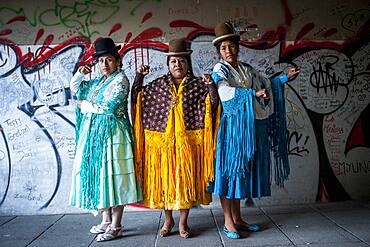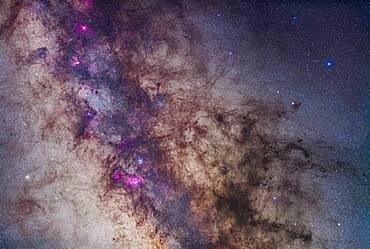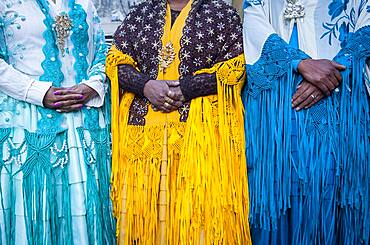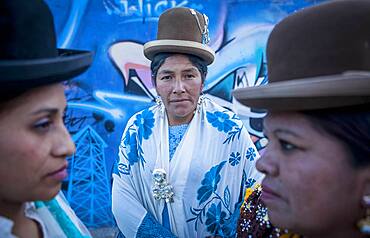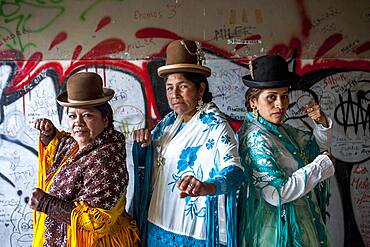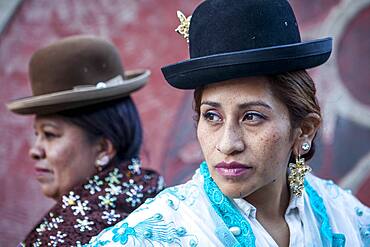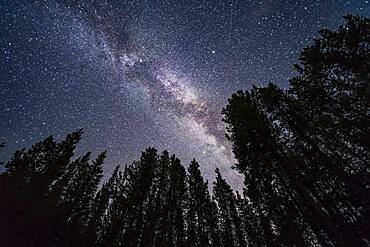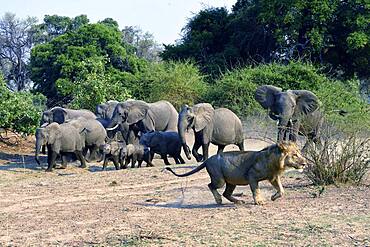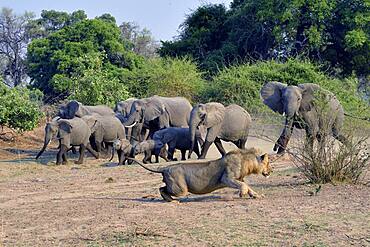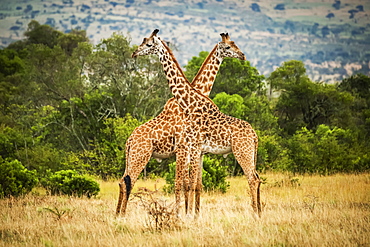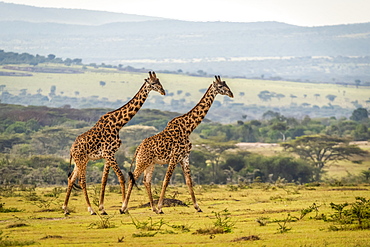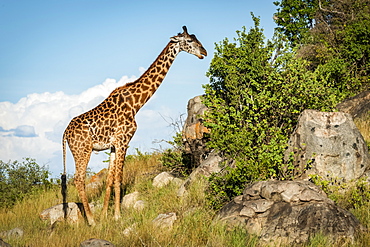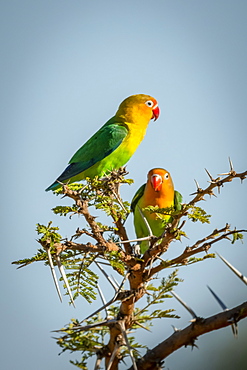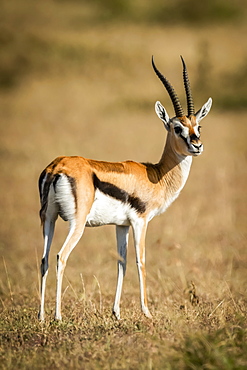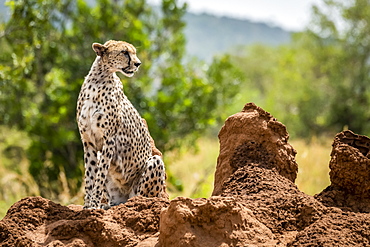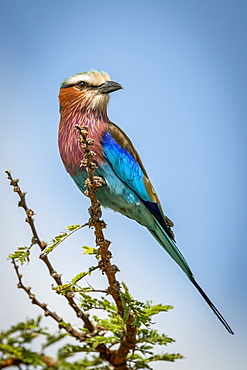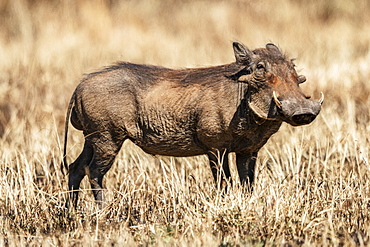Recent searches
Loading...
1350-154 - A blend of images to show the stars of the southern sky moving from east to west (left to right) over the peaks of the Continental Divide at Herbert Lake near Lake Louise, in Banff, Alberta. The main peak at left is Mount Temple.
1350-1099 - Takahiro Koizumi at right and his assistant kohei ishimori at left are making mud to build a molds to make a iron teapot or tetsubin, nanbu tekki,Workshop of Koizumi family,craftsmen since 1659, Morioka, Iwate Prefecture, Japan
1350-178 - The asterism of the False Cross in Vela and Carina, at left, with Gamma Velorum, a bright blue supergiant star, at right. In between are faint arcs of nebulosity in the Gum Nebula. To the left of Gamma Velorum is the open star clister NGC 2547. Below the bottom star of the False Cross, Epsilon Carinae or Avior, is the large naked-eye star cluster NGC 2516. To the right of the right star of the False Cross, Delta Velorum, is the loose open cluster IC 2391.
1350-1573 - At right Ulugh Sultan Begim mausoleum, in the middle Ustad Ali mausoleum, and at left Shad-i-Mulk Aqa mausoleum , Shah-i-Zinda complex, Samarkand, Uzbekistan
1350-133 - The amazing area of the southern Milky Way in Carina and Crux, the brightest part of the Milky Way after the galactic core region. At right is the Carina Nebula, with the Southern Pleiades cluster, IC 2602, below it. The Football Cluster, NGC 3532, is at upper left of the Carina Nebula. At centre is the region of Lambda Centauri, with the star cluster NGC 3766, the Pearl Cluster, above the emission nebulosity. At left is the Southern Cross, with the dark Coal Sack at bottom left of the Cross, with thin tendrils extending to the right. To the left of Alpha Cruxis at the bottom of the Cross is the star cluster NGC 4609; aboive Alpha is NGC 4649. To the left of Beta Cruxis at the left side of the Cross is the Jewel Box Cluster, NGC 4755.
1350-822 - At left Dina , in the middle Benita la Intocable, at right Angela la Folclorista, cholitas females wrestlers, El Alto, La Paz, Bolivia
1350-135 - The colourful region around Antares in Scorpius, the yellow star at centre. To the right is the globular cluster Messier 4. Above right of Antares is the smaller globular NGC 6144. Above are the nebulas associated with Rho Ophiuchi. The area is filled with reflection (yellow and blue) and emission nebulas (red and pink). The field simulates a binocular field.
1350-814 - At left Benita la Intocable , in the middle Angela la Folclorista, and at right Dina, cholitas females wrestlers, El Alto, La Paz, Bolivia
1350-130 - Particularly large groups of sunspots on the Sun on September 4, 2017. The group at bottom is AR 2673, the group at top is 2674. The small spot at left on the emerging limb is AR 2677, while the groups disappearing at right are AR 2675 (top) and AR 2776.
1350-41 - One of the 27 antennas of the Very Large Array (VLA) radio telescope complex in New Mexico (with others in the distance at lower right) illuminated by moonlight, on December 13, 2013, peak night for the Geminid meteor shower. A single exposure of 30 seconds with the Rokinon 14mm lens at f/2.8 and Canon 5D MkII at ISO 800. Orion is rising a lower centre. The Moon is the bright object at upper right. The Pleiades and Hyades are above centre.
1350-829 - At left Benita la Intocable , and at right Angela la Folclorista, cholitas females wrestlers, El Alto, La Paz, Bolivia
1350-59 - A wide-angle view of the Northern Hemisphere autumn Milky, from Aquila at bottom right in thw south, to Cassiopeia and Perseus at upper left in the northeast. Cygnus is at centre overhead on a late October evening. The Summer Triangle stars are at centre and right; the Andromeda Galaxy and Triangulum galaxies are at bottom left. The dark nebula Le Gentil 3, aka the Funnel Nebula, is at centre.
1350-789 - Mohammad Al-Amine Mosque and at right Saint Georges Maronite Cathedral, Beirut, Lebanon
1350-63 - Mark gazing at a target, M22, in the Milky Way with his TeleVue 127 refractor at the annual Rothney Observatory Milky Way Nights for July 25, 2019. Several satellite trails mark the sky. Jupiter (brightest at right) and Saturn (at left) flank the Milky Way.
1350-1586 - At left Hazroti Imom Friday Mosque and at right Moyie Mubarek Library Museum, Tashkent, Uzbekistan
1350-1524 - Islom Hoja Minaret. At right Sherghozi Khan Medressa. At left Pahlavon Mahmud Mausoleum, Khiva, Uzbekistan
1350-74 - Passengers observing and shooting the Northern Lights from the upper Deck 9 of the ms Trollfjord on the northbound voyage, Oct 16, 2019, north of Tromsø. Illumination is from the waning gibbous Moon in frame at right.
1350-603 - Perito Moreno Glacier and Lago Argentino in Los Glaciares National Park near El Calafate, Argentina. A UNESCO World Heritage Site in the Patagonia region of South America. At right is Cordon Reichert with the peak of Cerro Moreno at left.
1350-127 - The region of the Milky Way in Puppis and Vela encompassing the vast Gum Nebula, a photographic object only. Sirius and Canis Major are at right; Canopus in Carina is at bottom. The False Cross and the open cluster NGC 2516 are at left.
1350-113 - A superb display of aurora borealis seen on March 14, 2016 when it reached Level 5 storm levels. Here it begins in the evening twilight and in the light of the 6-day-old Moon. Jupiter is at right. This view is looking east.
1350-815 - At left Benita la Intocable , in the middle Angela la Folclorista, and at right Dina, cholitas females wrestlers, El Alto, La Paz, Bolivia
1350-86 - The eroding formations of Dinosaur Provincial Park, Alberta, lit by the rising gibbous Moon, off camera at right, on April 21/22, 2019. This is looking north, with the stars of the northern sky pivoting around Polaris.
1350-604 - Perito Moreno Glacier and Lago Argentino in Los Glaciares National Park near El Calafate, Argentina. A UNESCO World Heritage Site in the Patagonia region of South America. At right is Cordon Reichert.
1350-1186 - Sahar at right and Houriye at left, both 15 years old, Girls picking chards harvest, day laborers, child labour, syrian refugees, in Bar Elias, Bekaa Valley, Lebanon
1350-827 - At left Benita la Intocable , and at right Angela la Folclorista, cholitas females wrestlers, El Alto, La Paz, Bolivia
1350-35 - A mosaic of the region around the Small Sagittarius Starcloud and Dark Horse dark nebula complex. The field takes in the Milky Way from the Lagoon Nebula at bottom to the Eagle Nebula at top left. In between from top to bottom are the Swan Nebula (M17), and the Small Sagittarius Starcloud (M24). Flanking the bright M24 starcloud are the large open clusters M23 (right) and M25 (left). At bottom left is the M22 globular star cluster. The prominent dark nebula at right is the large Pipe Nebula (B78) with the small Snake Nebula (B72) above it. The whole complex is visible to the naked eye as the Dark Horse.
1350-172 - The centre of the Galaxy region in Sagittarius and Scorpius overhead in the wee hours of an April morning in Australia. At upper right are Alpha and Beta Centauri, while at lower left is Altair.
1350-109 - The rising autumn stars and constellations over and reflected in the lake at Police Outpost Provincial Park, in southern Alberta, on September 26, 2016. The stars of Auriga and Taurus are rising, including the Pleiades at upper right. Capella is the bright star above right centre; Aldebaran is below right in the sky. Both are reflected in the still water, along with the Hyades and Pleiades star clusters. A mild aurora is at left.
1350-115 - Comet NEOWISE (C/2020 F3) over some of the eroded hoodoo formations at Dinosaur Provincial Park, Alberta, July 14-15, 2020. A faint aurora is at right. The foreground is lit by starlight only; there was no light painting employed here.
1350-110 - Mars (at top) and Saturn (at left) in Scorpius (or thereabouts - Saturn is technically in Ophiuchus) above Antares and the dark and reflection nebulas around Antares. The globular M4 is visible to the right of Antares.
1350-17 - Nebulosity in the heart of Cygnus the Swan, including the North America Nebula and Pelican Nebula at left (NGC 7000 and IC 5070) and Gamma Cygni complex at right (IC 1318). The Crescent Nebula (NGC 6888) is at lower right. This is a stack of 5 x 4 minute exposures at f/2 with the 135mm lens and modified Canon 5D MkII at ISO 800, plus another three similar exposure images but taken thru the Kenko Softon filter for the star glows. Taken from home Sept 10, 2013.
1350-881 - Demonstration, indigenous women claim their rights, La Paz, Bolivia
1350-1499 - At right Kalon minaret and mosque. At left Mir-i-Arab medressa , Bukhara, Uzbekistan
1350-825 - Detail of dresses and hands. At left Benita la Intocable , in the middle Angela la Folclorista, and at right Dina, cholitas females wrestlers, El Alto, La Paz, Bolivia
1350-1172 - Skyline, Sumidagawa river and in background at right Mount Fuji, Tokyo, Japan
1350-828 - At left Benita la Intocable , in the middle Dina, and at right Angela la Folclorista, cholitas females wrestlers, El Alto, La Paz, Bolivia
1350-821 - At left Angela la Folclorista , in the middle Benita la Intocable, and at right Dina, cholitas females wrestlers, El Alto, La Paz, Bolivia
1350-1523 - Islom Hoja Minaret. At right Sherghozi Khan Medressa. At left Pahlavon Mahmud Mausoleum, Khiva, Uzbekistan
1350-1126 - Takahiro Koizumi at left and his assistant at right are showing their finish work, iron teapots or tetsubin, nanbu tekki,Workshop of Koizumi family,craftsmen since 1659, Morioka, Iwate Prefecture, Japan
1350-1500 - Minor Cafe House. At right Kalon minaret and mosque. At left Mir-i-Arab medressa , Bukhara, Uzbekistan
1350-816 - At left Angela la Folclorista , in the middle Dina, and at right Benita la Intocable, cholitas females wrestlers, El Alto, La Paz, Bolivia
1350-820 - At right Benita la Intocable , at left Angela la Folclorista, cholitas females wrestlers, El Alto, La Paz, Bolivia
1350-99 - The Northern Lights on Feb 16, 2015, as seen from the Churchill Northern Studies Centre, in Churchill, Manitoba at 58° latitude, and under the auroral oval. The aurora appeared as skies cleared somewhat during a blizzard with high winds and blowing snow conditions. I shot these from the second floor deck of the Centre, out of the wind and off the ground. Jupiter is at right, the Big Dipper at left.
1350-40 - The Very Large Array (VLA) radio telescope in New Mexico, at sunset, March 17, 2013, with the Earth shadow rising at right and the pink Belt of Venus along the eastern horizon. This is a 2-section panorama, hand-held, with the 14mm lens and Canon 60Da camera.
1350-22 - The complex area of clusters and nebulosity in central Auriga, including: M38 the Starfish Cluster and its smaller companion cluster NGC 1907; the emission/reflection nebulas NGC 1931, IC 417, IC 410 and IC 405 (from right to left here). Magenta and cyan (from emission and reflection components) IC 405 at right is the Flaming Star Nebula. Between IC 405 and IC 410 is the asterism known as The Little Fish.
1350-12 - A mosaic of the region around the centre of the Milky Way in Sagittarius and Scorpius. The field takes in the Milky Way from the Cat's Paw Nebula at bottom edge to the Eagle Nebula at top left. In between from top to bottom are the Swan Nebula (M17), the Small Sagittarius Starcloud (M24), the Trifid and Lagoon Nebulas (M20 and M8) and the open clusters M6 and M7. The prominent dark nebula at right is the large Pipe Nebula (B78) with the small Snake Nebula (B72) above it. The whole complex is visible to the naked eye as the Dark Horse.
1350-118 - Comet NEOWISE (C/2020 F3) reflected in the still waters this night of Crawling Lake in southern Alberta. A dim aurora at right colours the sky magenta. Lingering twilight colours the sky blue. A meteor or more likely a flaring satellite appears at right and is also reflected in the water. Even in this short exposure, the two tails ' dust and ion ' are visible. This was July 20, 2020.
1350-49 - The large emission nebula IC 1805 in Cassiopeia, aka the Heart Nebula. The round nebula at top right is NGC 896. The large loose star cluster at centre is Mel 15; the star cluster at left is NGC 1027. The small cluster below NGC 896 is Tombaugh 4.
1350-123 - NGC 7000, the North America Nebula, with the Pelican Nebula, IC 5067, at right, in Cygnus, taken from home November 21, 2016 as part of testing of the Explore Scientific FCD100 102mm apo refractor. This is a stack of 5 x 6-minute exposures at f/7 with the ES field flattener, and at ISO 1600 with the filter-modified Canon 5D MkII. Star diffraction spikes added with AstronomyTools actions.
1350-13 - The centre of the galaxy area of the Milky Way toward Sagittarius and Scorpius, with the Sagittarius Starcloud right of centre, and the Lagoon Nebula (M8) left of centre. The Cat's Paw Nebula (NGC 6334) in Scorpius is at upper right, the Swan Nebula (M17) and Eagle Nebula (M16) are at lower left. To the right of them is the Small Sagittarius Starcloud (M24). At the very top is the Snake Nebula (B72). The main mass of dark nebula is the Pipe Nebula (B78). Above M24 at left is the open cluster M23 while below the M24 star cloud is the cluster M25. The globular M22 is at the bottom edge. At right of frame are the open clusters M6 (in the dark area of the Milky Way) and M7 (in the bright starcloud).
1350-122 - A composite of the August 21, 2017 total eclipse of the Sun, showing the second and third contact diamond rings and Baily's Beads at the start (left) and end (right) of totality, flanking a composite image of totality itself. The diamond ring and Baily's Beads images are single images.
1350-137 - A horizon-to-zenith panorama of the winter consellations on a March evening as they set into the southwest. Orion is at bottom centre, with his Belt pointing down to Canis Major and up to Taurus. Gemini and Auriga are at top, in this case near the zenith overhead. The bright star clusters, M44, the Beehive, (at left) and M45, the Pleiades, (at right) flank the Milky Way. M45 is embedded in the Zodiacal Light. The star clusters M35 in Gemini and M41 in Canis Major are also visible as diffuse spots, as are several other star clusters. A couple of satellite trails are visible.
1350-92 - Comet Lovejoy (C/2104 Q2) on the night of Dec. 27/28, 2014, as it was approaching the globular cluster M79 at upper right, in Lepus. This is a stack of 5 x 3 minute exposures at ISO 2500 with the Canon 5D MkII and TMB 92mm refractor at f/4.4. Taken from near Silver City, New Mexico.
1350-152 - The constellation of Orion the Hunter, at right, and his two Hunting Dogs and their brightest stars: Procyon in Canis Minor (at left) and Sirius in Canis Major (at bottom).
1350-102 - The Big Dipper in hazy clouds over the Waterton River at Maskinonge Pond, September 23, 2016, taken at the Night Photography Workshop I conducted there that night. The glow at right is light pollution from the Shell Waterton Gas Plant and from Pincher Creek to the north.
1350-170 - The summer Milky Way overhead and through the Summer Triangle stars in July, looking up through trees in Banff National Park at Herbert Lake. Deneb is at top left, Vega at top right, and Altair is at bottom. The bright Cygnus star cloud is obvious. As are the dark lanes in the Milky Way, including the Funnel Nebula at top, aka Le Gentil 3.
1350-11 - The Belt of Orion with the Horsehead Nebula at botton, the dark nebula set in the bright emission nebula IC 434. The nebula at left of the Zeta Orionis (aka Alnitak) is the Flame Nebula, NGC 2024. The reflection nebula at upper left is the M78 complex with NGC 2071. The other Belt stars are Alnilan (centre) and Mintaka (upper right). The field contains a wealth of other blue reflection and red emission nebulas.
1350-16 - Comet Holmes, 17P, taken Nov 1, 2007 on excellent night. Taken with A&M 105mm apo refractor at f/5 with Borg 0.85x compressor/field flattener on SkyWatcher HEQ5 mount. Canon 20Da camera at ISO400. Composite of 4 min, 2min, 1min, 30sec, 15sec, and 7 sec exposures, each exposure being a stack of 3 to 4 identical exposures. Registered and stacked in Photoshop (HDR mode did not produce usable result, so manually composited with sucessively smaller masks to reveal short exposure content around nucleus. Contrast exaggerated with Curves to bring out very faint tail structure. North up, so tail to the S and SW.Nucleus is dot at upper left of inner coma, other star in inner coma at right is a field star
1350-143 - Mars (at left) and the galactic centre area of the summer Milky Way low over the southern horizon at Writing-on-Stone Provincial Park, Alberta, on June 8/9, 2018. Sagittarus is at centre, with Scorpius at right. The Messier 6 and 7 open star clusters are just above the horizon at centre, just right of the Sweetgrass Hills on the horizon in Montana.
1350-72 - An arc of Northern Lights appears in the evening twilight over Prelude Lake near Yellowknife, NWT, on September 9, 2019. The Big Dipper is at left. Capella is at right.
1350-159 - Circumpolar star trails over a grand old barn in southern Alberta, on a fine spring night, May 23, 2018. Illumination is from the waxing gibbous Moon to the south. This is looking north to Polaris at top right. A thunderstorm is on the northern horizon with a lightning bolt as a bonus.
1348-2147 - Bilateral lesions of the caudate heads, the putamens, and the internal posterior region of the two thalami (image on the right).
1348-2246 - Affecting the two caudate nuclei in the head, the two putamens and the posterointernal part of the two thalamus (on the right document).
1348-2146 - Bilateral lesions of the caudate heads, the putamens, and the internal posterior region of the two thalami (image on the right).
860-288783 - Aerial view of a Bowhead whale, (Balaena mysticetus), also known as Greenland right whales, can weigh from 75 to 100 tonnes, swimming in the shallow waters in Vrangel Bay of the Sea of Okhotsk, eastern Russia.
860-288865 - African savannah elephants (Loxodonta africana africana), the lion finally releases in front of the charge of the right elephant, South Luangwa NP, Zambia
860-288784 - Aerial view of a Bowhead whale, (Balaena mysticetus), also known as Greenland right whales, can weigh from 75 to 100 tonnes, swimming in the shallow waters in Vrangel Bay of the Sea of Okhotsk, eastern Russia.
860-288864 - African savannah elephants (Loxodonta africana africana), the lion eventually stands up before the load of the right elephant, South Luangwa NP, Zambia
1345-17 - Elephant seal (Mirounga leonina), Right Whale Bay
1345-15 - Antarctic Fur Seals (Arctocephalus gazella) in Right Whale Bay, South Georgia Island
1116-49331 - Blue wildebeest (Connochaetes taurinus) stands in profile on grass, Serengeti, Tanzania
1116-49292 - Black-shouldered kite (Elanus caeruleus) facing right in bare branches, Serengeti, Tanzania
1116-49196 - Leopard (Panthera pardus) sits under a tree looking to the right, Northern India, Rajasthan, India
1116-49192 - Leopard (Panthera pardus) lays on a rock looking to the right, Northern India, Rajasthan, India
1116-49303 - Lappet-faced vulture (Torgos tracheliotos) on thornbush under blue sky, Serengeti, Tanzania
1116-49310 - Two Masai giraffe (Giraffa camelopardalis tippelskirchii) crossing necks by trees, Serengeti, Tanzania
1116-49372 - Spider-Man agama (Agama mwanzae) lizard basks on sunlit rock, Serengeti, Tanzania
1116-49362 - Marabou stork (Leptoptilos crumenifer) stands on rock turning head, Serengeti, Tanzania
1116-49276 - African white-backed vulture (Gyps africanus) flying over grassy hillside, Serengeti, Tanzania
1116-49330 - Cheetah (Acinonyx jubatus) sits looking round on termite mound, Serengeti, , Tanzania
1116-49311 - Two Masai giraffe (Giraffa camelopardalis tippelskirchii) walking across grassy plain, Serengeti, Tanzania
1116-49363 - Masai giraffe (Giraffa camelopardalis tippelskirchii) browsing bushes on rocky slope, Serengeti, Tanzania
1116-49354 - Two Fischer's lovebirds (Agapornis fischeri) perched in thorn tree, Serengeti, Tanzania
1116-49369 - Rimlit spotted hyena (Crocuta crocuta) sitting in long grass, Serengeti, Tanzania
1116-49179 - Close-up portrait of lioness (Panthera Leo), Katavi National Park, Tanzania
1116-49361 - Male lion (Panthera leo) stretches in grass facing right, Serengeti, Tanzania
1116-49374 - Thomson's gazelle (Eudorcas thomsonii) stands on grass turning head, Serengeti, Tanzania
1116-49410 - Pair of Burrowing Owls (Athene cunicularia) perched on Cholla cactus (Cylindropuntia) skeleton, Casa Grande, Arizona, United States of America
1116-49295 - Cheetah (Acinonyx jubatu) sitting on termite mound turning head, Serengeti, Tanzania
1116-49211 - Bengal tiger (Panthera tigris tigris), Ranthambore National Park, India
1116-49323 - Superb starling (Lamprotornis superbus) on dead branch turns head, Serengeti, Tanzania
1116-49156 - Young Chimpanzee (Pan troglodytes) resting in a tree in Mahale Mountains National Park on the shore of Lake Tanganika, Tanzania
1116-49317 - Lilac-breasted roller (Coracias caudatus Linnaeus) perches on branch turning head, Serengeti, Tanzania
1116-49341 - Common warthog (Phacochoerus africanus) eyes camera in burned grass, Serengeti, Tanzania
1116-49210 - Bengal tiger (Panthera tigris tigris), Ranthambore National Park, India
1116-49195 - Leopard (Panthera pardus) stands under a tree looking to the right, Northern India, Rajasthan, India
1116-50401 - Close-up of cheetah (Acinonyx jubatus) face against blurred background, Klein's Camp, Serengeti National Park; Tanzania
1116-50400 - Close-up of lioness (Panthera leo) sitting with blurred background, Cottar's 1920s Safari Camp, Maasai Mara National Reserve; Kenya
1116-50324 - Two puma on the landscape in Southern Chile; Chile
1116-50405 - Close-up of cheetah (Acinonyx jubatus) turning blood-stained head right, Klein's Camp, Serengeti National Park; Tanzania









